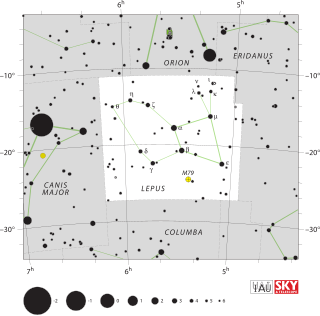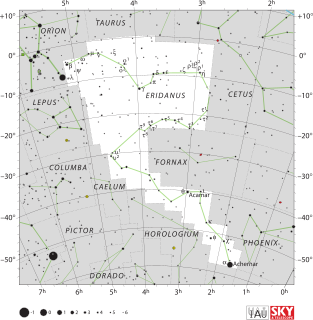External links
| General | |
|---|---|
| National libraries | |
| Other | |
Wil Tirion (born February 19, 1943) is a Dutch uranographer (celestial cartographer). His most famous work, Sky Atlas 2000.0, is renowned by astronomers for its accuracy and beauty. [1] The second edition of his most complete work, Uranometria 2000.0, was published in 2001 by Willmann-Bell. [2] He is also responsible for the sky charts found in many other publications. He was originally a graphic designer. The minor planet (asteroid) 4648 Tirion is named after him.

A constellation is an area on the celestial sphere in which a group of visible stars forms a perceived outline or pattern, typically representing an animal, mythological person or creature, or an inanimate object.

Equuleus is a constellation of stars that are visible in the night sky. Its name is Latin for "little horse", a foal. Located on the northern celestial hemisphere, it was one of the 48 constellations listed by the 2nd century astronomer Ptolemy, and remains one of the 88 modern constellations. It is the second smallest of the modern constellations, spanning only 72 square degrees. It is also very faint, having no stars brighter than the fourth magnitude.

Hydrus is a small constellation in the deep southern sky. It was one of twelve constellations created by Petrus Plancius from the observations of Pieter Dirkszoon Keyser and Frederick de Houtman and it first appeared on a 35-cm (14 in) diameter celestial globe published in late 1597 in Amsterdam by Plancius and Jodocus Hondius. The first depiction of this constellation in a celestial atlas was in Johann Bayer's Uranometria of 1603. The French explorer and astronomer Nicolas Louis de Lacaille charted the brighter stars and gave their Bayer designations in 1756. Its name means "male water snake", as opposed to Hydra, a much larger constellation that represents a female water snake. It remains below the horizon for most Northern Hemisphere observers.

Johann Bayer was a German lawyer and uranographer. He was born in Rain, Lower Bavaria, in 1572. At twenty, in 1592 he began his study of philosophy and law at the University of Ingolstadt, after which he moved to Augsburg to begin work as a lawyer, becoming legal adviser to the city council in 1612.

Libra is a constellation of the zodiac and is located in the Southern celestial hemisphere. Its name is Latin for weighing scales. Its old astronomical symbol is (♎︎). It is fairly faint, with no first magnitude stars, and lies between Virgo to the west and Scorpius to the east. Beta Librae, also known as Zubeneschamali, is the brightest star in the constellation. Three star systems are known to have planets.

Lepus is a constellation lying just south of the celestial equator. Its name is Latin for hare. It is located below—immediately south—of Orion, and is sometimes represented as a hare being chased by Orion or by Orion's hunting dogs.

Volans is a constellation in the southern sky. It represents a flying fish; its name is a shortened form of its original name, Piscis Volans. Volans was one of twelve constellations created by Petrus Plancius from the observations of Pieter Dirkszoon Keyser and Frederick de Houtman and it first appeared on a 35-cm diameter celestial globe published in 1597 in Amsterdam by Plancius with Jodocus Hondius. The first depiction of this constellation in a celestial atlas was in Johann Bayer's Uranometria of 1603.

Columba is a faint constellation designated in the late sixteenth century, remaining in official use, with its rigid limits set in the 20th century. Its name is Latin for dove. It takes up 1.31% of the southern celestial hemisphere and is just south of Canis Major and Lepus.

Indus is a constellation in the southern sky first professionally surveyed by Europeans in the 1590s, namely Dutchmen, and mapped on a globe by Pieter Platevoet (Plancius) by early 1598 and thus included in Bayer's keynote, consolidated sky atlas of 1603. On average it is centred, that is to say its zenith, is over 25° south of the Tropic of Capricorn. South of the Tropic lie only four countries, the rest being parts of oceans and Antarctica and ten countries straddle the tropic but the bright right-angled triangle can be seen for most of the year from the Equator. It has a north-south elongated, complex scope and its other English direct translation of its name is sometimes seen in old writings, the Indian as it is in other European languages.
Brian A. Skiff is an American astronomer noted for discovering numerous asteroids and a number of comets including the periodic comets 114P/Wiseman–Skiff and 140P/Bowell–Skiff.
Jean Meeus is a Belgian meteorologist and amateur astronomer specializing in celestial mechanics, spherical astronomy, and mathematical astronomy.

Eridanus is a constellation in the southern celestial hemisphere. It is represented as a river. One of the 48 constellations listed by the 2nd century astronomer Ptolemy, it remains one of the 88 modern constellations. It is the sixth largest of the modern constellations, and the one that extends farthest in the sky from north to south. The same name was later taken as a Latin name for the real Po River and also for the name of a minor river in Athens.

60 Andromedae is a star system in the northern constellation of Andromeda, located to the west-northwest of Gamma Andromedae. 60 Andromedae is the Flamsteed designation though the star also bears the Bayer designation b Andromedae. It is bright enough to be seen by the naked eye with an apparent visual magnitude of 4.82. Based upon parallax measurements made during the Hipparcos mission, it is at a distance of roughly 530 light-years from Earth.
True north is the direction along Earth's surface towards the geographic North Pole or True North Pole.

Ian William Ridpath is an English science writer and broadcaster best known as a popularizer of astronomy and a biographer of constellation history. As a UFO sceptic, he investigated and explained the Rendlesham Forest Incident of December 1980.

Celestial cartography, uranography, astrography or star cartography is the aspect of astronomy and branch of cartography concerned with mapping stars, galaxies, and other astronomical objects on the celestial sphere. Measuring the position and light of charted objects requires a variety of instruments and techniques. These techniques have developed from angle measurements with quadrants and the unaided eye, through sextants combined with lenses for light magnification, up to current methods which include computer-automated space telescopes. Uranographers have historically produced planetary position tables, star tables, and star maps for use by both amateur and professional astronomers. More recently, computerized star maps have been compiled, and automated positioning of telescopes uses databases of stars and of other astronomical objects.
A Celor lens is a highly corrected lens of the Dialyt type, designed for process photography, involving reproduction at or near 1:1 scale.
The Millennium Star Atlas was constructed as a collaboration between a team at Sky & Telescope led by Roger Sinnott, and the European Space Agency's Hipparcos project, led by Michael Perryman. This 1997 work was the first sky atlas to include the Hipparcos and Tycho Catalogue data, extending earlier undertakings in terms of completeness and uniformity to a magnitude limit of around 10–11 magnitude. It appeared as a stand-alone publication, and as three volumes of the 17-volume Hipparcos Catalogue.

An astronomical catalog or catalogue is a list or tabulation of astronomical objects, typically grouped together because they share a common type, morphology, origin, means of detection, or method of discovery. The oldest and largest are star catalogues. Hundreds have been published, including general ones and special ones for such items as infrared stars, variable stars, giant stars, multiple star systems, star clusters, and so forth.